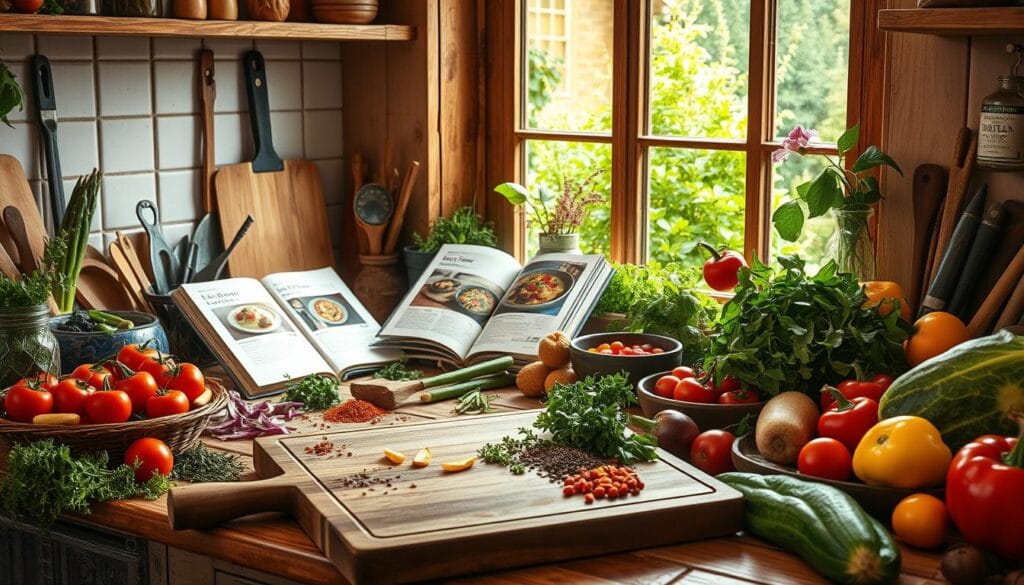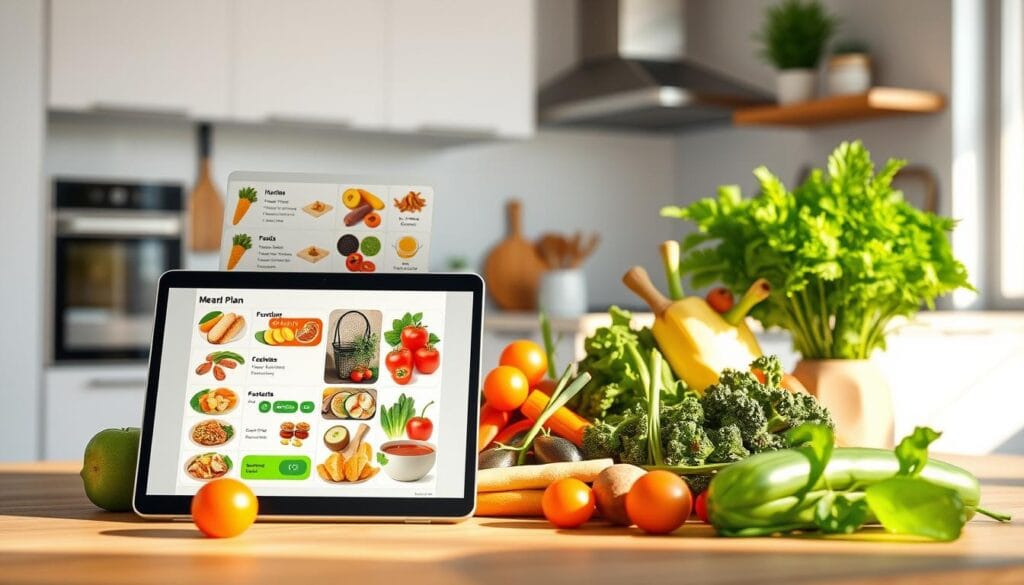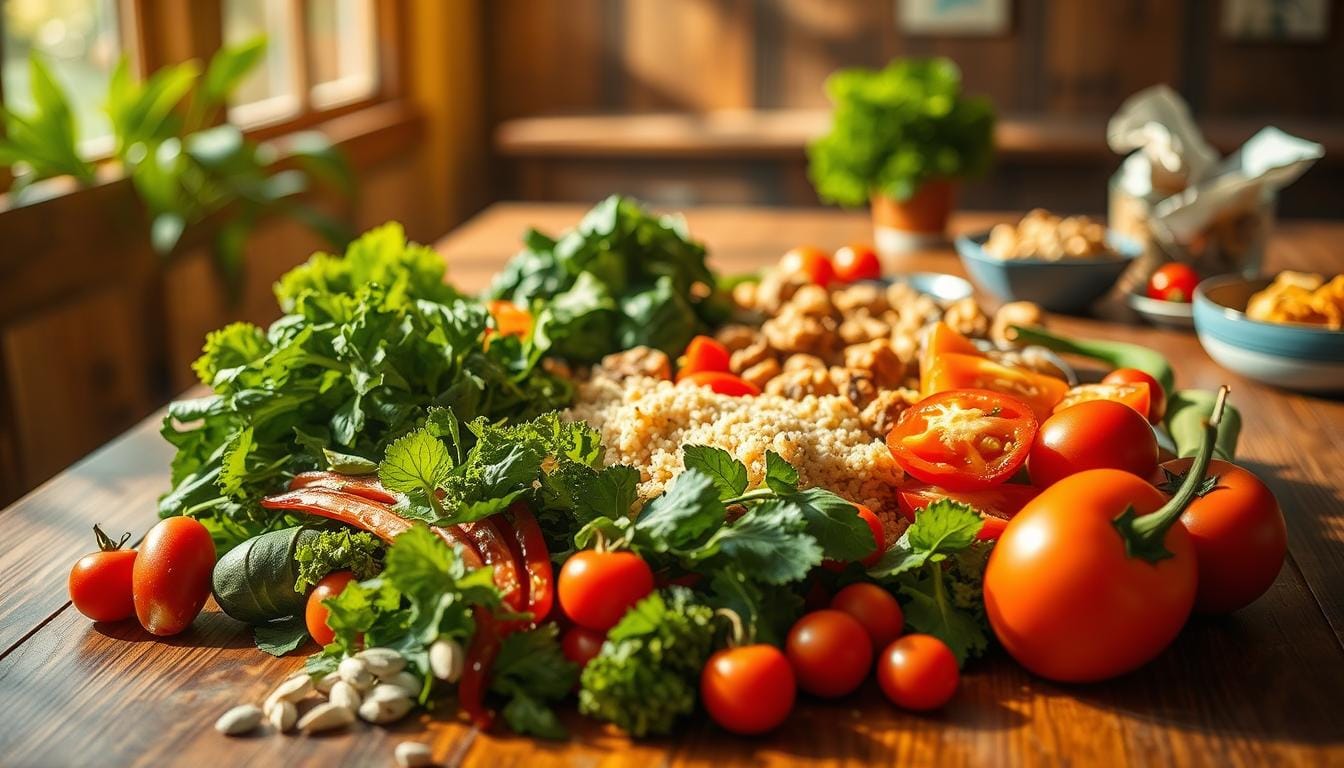1200 Meal Plan to Boost Your Energy Levels
Ever feel like your day runs on empty? You’re not alone. Between juggling work, family, and personal goals, maintaining steady energy can feel impossible. What if the right foods could change that?
A calorie-controlled approach isn’t just about numbers—it’s about fueling your body smartly. By focusing on whole foods rich in protein and fiber, this strategy helps stabilize blood sugar while keeping hunger at bay. Imagine ending the 3 p.m. crash cycle for good.
Registered dietitians designed this method to prioritize nutrition without sacrificing flavor. Each meal balances lean proteins, complex carbs, and healthy fats to sustain energy. You’ll discover how strategic ingredient reuse cuts prep time, making consistency effortless.
Safety matters, too. Sticking to 1,200 calories daily requires precision to avoid nutrient gaps. That’s why every recipe emphasizes vitamins and minerals alongside taste. Think of it as a roadmap—not a restriction—to feeling your best.
Ready to reclaim your vitality? Let’s explore how smart planning turns meals into momentum.
Table of Contents
Introduction to a 1200-Calorie Meal Plan
Want a structured approach to eating that fuels your day? This guide gives you tools to manage weight loss while keeping energy steady. You’ll learn how smart food choices create lasting results—without endless hunger or fatigue.
What You Can Expect from This Guide
Each day combines nutrient-rich foods in precise portions. Recipes reuse ingredients to save time—think grilled chicken at lunch becoming dinner’s salad topping. Breakfast gets special attention because starting strong sets the tone for healthier choices later.
The table below shows how meals balance calories and nutrients:
| Meal Time | Focus | Example |
|---|---|---|
| Breakfast | Protein + Fiber | Greek yogurt with berries |
| Lunch | Lean Protein + Veggies | Grilled chicken salad |
| Dinner | Complex Carbs + Healthy Fats | Salmon with quinoa |
Prep tips make sticking to your goals easier. Batch-cook grains on Sundays. Use leftover veggies in omelets. Small steps add up to big changes.
Understanding Your Calorie Needs
Ever wonder why some diets work for others but not you? Your body’s unique energy requirements hold the answer. Knowing your resting metabolic rate (RMR)—the calories burned at rest—is like having a blueprint for smarter eating.
Calculating Your Resting Metabolic Rate
RMR forms the foundation of your daily calorie needs. Experts often use formulas like Mifflin-St Jeor or Harris-Benedict, which factor in your height, weight, and age. For example:
- Women: (10 × weight in kg) + (6.25 × height in cm) – (5 × age) – 161
- Men: (10 × weight in kg) + (6.25 × height in cm) – (5 × age) + 5
These equations estimate baseline needs. But they’re just the starting point.
Personalizing Calorie Intake
Your activity level and goals reshape the math. A construction worker needs more fuel than an office worker. Weight loss? Aim for a modest deficit. Muscle gain? Increase intake strategically.
Protein plays a starring role here. It keeps you fuller longer and preserves muscle during calorie adjustments. Pair it with fiber-rich veggies for steady energy.
For precision, consult a registered dietitian. They’ll analyze your lifestyle, health history, and preferences to tailor recommendations. Whether you’re targeting 1,200 calories or higher, personalized nutrition ensures you meet goals without burnout.
Benefits of a 1200-Calorie Diet for Weight Loss
Struggling to shed pounds without feeling drained? Cutting calories strategically helps create lasting change. When guided by professionals, this method supports fat loss while protecting muscle mass and energy reserves.
A moderate deficit keeps your body burning stored fat instead of muscle. “A structured approach ensures your body gets what it needs while creating a sustainable deficit,” notes a registered dietitian. You’ll see steady progress without extreme hunger or fatigue.
Balanced meals play a key role here. Prioritizing protein and fiber-rich foods maintains blood sugar stability. This combo reduces cravings and keeps you satisfied between meals.
| Benefit | How It Works | Supporting Foods |
|---|---|---|
| Steady Weight Reduction | Creates 500-750 calorie daily deficit | Lean proteins, leafy greens |
| Fat Burning Boost | Preserves metabolism through nutrient timing | Avocado, nuts, olive oil |
| Improved Vitality | Balanced macros prevent energy crashes | Whole grains, berries, eggs |
Portion control becomes effortless when meals pack nutritional value. You’ll naturally eat smaller amounts because nutrient-dense foods satisfy faster. This approach also teaches mindful eating habits that outlast any diet phase.
Safety remains paramount. Though effective for shedding excess weight, extremely low intake requires expert oversight. Regular check-ins ensure you’re meeting vitamin and mineral needs while progressing toward goals.
Implementing a 1200 Meal Plan for Weight Loss Success
Tired of diets that fizzle out after a week? This approach sticks because it combines structure with flexibility. You’ll learn how small, consistent choices create lasting results—without turning your kitchen into a full-time job.
Why This Approach Works for Many People
Start by choosing three core proteins and grains each week. Grill chicken breasts, cook quinoa, and roast veggies on Sunday. Reuse these in salads, wraps, and stir-fries to slash prep time.
Set specific targets like losing 1-2 pounds weekly. Write them down and track progress daily. Apps or journals help spot patterns—like craving snacks at 4 p.m.—so you can adjust portions or add protein-rich snacks.
Eating at regular intervals keeps energy steady. Aim for meals every 3-4 hours. Skip this, and hunger might derail your efforts. Prep grab-and-go options like hard-boiled eggs or chopped veggies to stay on track.
One secret? Double-duty ingredients. Use tonight’s roasted sweet potatoes in tomorrow’s breakfast hash. This cuts waste and decision fatigue. You’ll spend less time cooking and more time enjoying results.
Finally, celebrate small wins. Notice tighter jeans or better focus? Those victories fuel motivation. Consistency beats perfection—every smart choice adds up.
Meal Plan Menu Guide Overview
Need a clear path to meals that work harder than you do? This guide reveals how smart combinations of ingredients power your day. Each dish builds on three pillars: lean proteins, colorful vegetables, and fiber-rich foods that keep you satisfied for hours.
What Makes Each Plate Effective
Every serving balances nutrients to prevent energy slumps. Lean proteins like turkey or tofu rebuild muscle while curbing cravings. Pair them with roasted veggies for vitamins and crunch. Add whole grains or legumes for slow-burning fuel.
Your lunch options rotate weekly to dodge boredom. Try grilled shrimp bowls on Monday and lentil wraps by Friday. This variety ensures you get different nutrients while sticking to your goals.
| Meal Component | Role | Example |
|---|---|---|
| Protein | Muscle repair & fullness | Grilled chicken breast |
| Vegetables | Vitamins & digestion | Steamed broccoli |
| Fiber Sources | Blood sugar control | Quinoa or black beans |
Fresh ingredients matter most. Frozen spinach works in a pinch, but crisp greens pack more texture and nutrients. Always check labels for added sugars in packaged foods—they sneak into sauces and dressings.
Choosing the right foods does double duty. You’ll notice better focus during work hours and steadier energy for evening workouts. It’s not just about eating less—it’s about fueling smarter.
Weekly Meal Prep Strategies
Ever wish you could clone your productive Sunday self for the whole week? Strategic preparation turns kitchen time into momentum-building sessions. A little upfront effort keeps your fridge stocked with ready-to-eat options that match your goals.
Time-Saving Tips and Ingredient Reuse
Start by chopping versatile veggies first. Dice a cucumber once, then use it in three ways: Greek yogurt dips, water-infused drinks, and salad bowls. Store portions in half-cup containers for grab-and-go convenience.
Pre-portion snacks like roasted chickpeas or apple slices into reusable cups. This prevents overeating while saving minutes during hectic mornings. “Batch-prepping proteins and grains creates flexibility,” says nutrition coach Lisa Yang. “You’re building blocks, not rigid meals.”
| Ingredient | Meal 1 | Meal 2 | Snack Use |
|---|---|---|---|
| Diced Cucumber | Tzatziki sauce | Quinoa salad | Veggie cups with hummus |
| Cooked Chicken | Stir-fry | Wrap filling | Protein-boosted soup |
| Steamed Rice | Buddha bowls | Fried “cauliflower” rice | Portable sushi bites |
Use stackable containers labeled with days of the week. Fill two-thirds with prepped ingredients, leaving space for last-minute additions. This system lets you mix flavors without daily cooking marathons.
Freeze smoothie ingredients in cup-sized bags—just add liquid and blend. For snacks, trail mix divided into single servings stops mindless munching. With these hacks, you’ll spend less time stressing and more time thriving.
Balanced Nutrition on a 1200-Calorie Diet
Nutrition isn’t just about counting numbers—it’s about solving a daily puzzle. Your body requires specific nutrients to thrive, even when managing calorie intake. With careful planning, you can meet those needs while enjoying satisfying meals.
Prioritizing Key Nutrients
Protein and fiber work together to keep hunger in check. They slow digestion, stabilize blood sugar, and help you feel fuller longer. Registered dietitian Dr. Emily Carter notes: “A well-designed approach ensures every bite delivers value, especially when calories are limited.”
Greek yogurt shines here. A single serving packs 15-20 grams of protein plus gut-friendly probiotics. Pair it with berries for fiber or mix into smoothies for creaminess. Other smart choices include cottage cheese, eggs, and lentils.
Focus on these nutrient-dense foods:
- Leafy greens like spinach (iron and folate)
- Colorful veggies such as bell peppers (vitamin C)
- Whole grains like quinoa (fiber and magnesium)
Balance doesn’t mean bland. Roast almonds for crunch, add citrus zest to salads, or blend herbs into dressings. These tweaks boost flavor without empty calories. You’ll discover that eating well feels less like a chore and more like self-care.
By emphasizing quality over quantity, you support your body’s needs while staying energized. It’s not about restriction—it’s about making every calorie work harder for you.
Leveraging Convenience Foods in Your Meal Plan
Short on time but still want nutritious meals? Smart shortcuts exist. Busy schedules demand practical solutions—without sacrificing quality. Premade items and leftovers can become allies when chosen wisely.
Maximizing Healthy Premade Options and Leftovers
Reach for convenience foods during hectic weeknights or travel days. Frozen vegetables retain nearly the same nutrients as fresh. Pair them with pre-cooked brown rice for a balanced dinner in minutes. Just measure portions using measuring cups to stay within calorie goals.
| Convenience Food | Use Case | Upgrade Tip |
|---|---|---|
| Whole grain toast | Quick breakfast | Top with smashed avocado + red pepper flakes |
| Pre-packaged salads | Lunch emergencies | Add canned tuna for protein |
| Rotisserie chicken | Dinner base | Shred into stir-fries or wraps |
Portion control matters. A cup of premade soup makes a satisfying starter. Two cups of frozen stir-fry mix fill half your plate with veggies. Sprinkle black pepper or chili powder to boost flavor without extra calories.
Balance ready-made items with fresh elements. Toss pre-washed spinach into canned lentil soup. Add cherry tomatoes to microwaveable quinoa bowls. This approach keeps meals vibrant and nutrient-dense.
Exploring Sample Menus and Recipe Inspiration
Looking for fresh ways to energize your mornings and evenings? These creative dishes prove that eating well doesn’t mean sacrificing flavor. Let’s dive into tasty options designed to keep your day on track.

Breakfast Ideas for a Quick Start
Kick off your morning with muffin-tin quiches packed with spinach and feta. They’re portable, protein-rich, and ready in 25 minutes. Prefer something sweet? Blend oats, banana, and almond milk into a no-cook smoothie bowl topped with chia seeds.
Lunch and Dinner Options to Keep It Interesting
Slow-cooker vegetable soup simmers while you work, delivering hearty flavor with minimal effort. For dinner, try stuffed sweet potatoes loaded with black beans and avocado. Rotate these recipes weekly to avoid monotony:
- Zucchini noodles with turkey meatballs
- Grilled shrimp skewers over cauliflower rice
- Chickpea curry with roasted broccoli
These templates adapt easily. Swap proteins, experiment with spices, or adjust portions to match your preferences. Every recipe prioritizes whole ingredients, proving that simplicity and nourishment go hand in hand.
Creative Meal Prep and Recipe Reuse Ideas
Want to turn one cooking session into three stress-free meals? Strategic prep transforms leftovers into exciting new dishes while cutting kitchen time. Let’s explore how to make your freezer and fridge work smarter.
Freezer Techniques and Reheating Tips
Freezing meals preserves freshness without losing nutrients. Portion cooked grains like quinoa into 3/4 cup servings using silicone molds. Store in airtight bags labeled with dates—most dishes stay fresh for 3 months.
Reheat soups and stews gently. Thaw overnight in the fridge, then warm on the stove at medium heat. Stir occasionally to maintain texture. For crispy items like roasted veggies, use an air fryer instead of microwaving.
| Ingredient | Breakfast Use | Dinner Use |
|---|---|---|
| Grilled Chicken | Scramble with eggs | Add to grain bowls |
| Steamed Broccoli | Mix into omelets | Blend into pesto pasta |
| Cooked Quinoa | Yogurt parfait topping | Stuffed pepper filling |
Batch-prep breakfasts like chia pudding or egg muffins. Layer Greek yogurt with frozen berries in jars—they’ll thaw by morning. For toast variations, keep pre-sliced whole grain bread in the freezer. Toast straight from frozen for a crunchy base.
Repurpose dinner proteins creatively. Last night’s salmon becomes today’s salad topping. Blend roasted veggies into dips or fold into whole wheat wraps. This approach reduces waste while keeping flavors fresh.
Expert Advice and Practical Meal Prep Tips
Need meal prep hacks that actually stick? Professionals agree: small tweaks make big differences. Let’s dive into strategies that turn chaotic kitchens into organized nutrition hubs.
Insights from Registered Dietitians
Registered dietitian Sarah Collins emphasizes balance: “Always pair protein with fiber in snacks. This combo keeps energy steady and prevents mindless munching.” Her go-to? Apple slices with almond butter or hard-boiled eggs with carrot sticks.
Weekly planning starts with simplicity. Dedicate 30 minutes each weekend to washing and chopping veggies. Store them in clear containers at eye level—you’ll grab them first when hunger strikes.
| Snack Idea | Prep Time | Calories |
|---|---|---|
| Greek yogurt + berries | 2 minutes | 120 |
| Turkey roll-ups | 5 minutes | 90 |
| Edamame pods | 3 minutes | 100 |
Rotate three core proteins each week—like chicken, tofu, and lentils—to avoid burnout. Batch-cook them Sunday night for easy assembly later. “Consistency matters more than perfection,” Collins notes. “Even partial prep reduces takeout temptations.”
Struggling with portions? Use your palm as a guide for proteins and fists for veggies. This visual method keeps servings balanced without scales. For lasting success, consult a nutrition expert to tailor strategies to your lifestyle.
Adapting Your Plan to Meet Individual Needs
Your body isn’t a spreadsheet—it’s a dynamic system that thrives on personalized care. What works for others might leave you hungry or unsatisfied. The key? Tailoring your approach to match your unique lifestyle and biology.

Start by assessing your daily energy demands. A construction worker needs more calories than someone with a desk job. If workouts leave you drained, add 100-150 calories through nuts or Greek yogurt. “Small adjustments prevent burnout while keeping progress steady,” advises dietitian Mara Simmons.
Overcoming Common Challenges
Cravings often signal unmet needs. Swap sugary snacks for roasted chickpeas or dark chocolate-covered almonds. Bored with meals? Rotate spices—smoked paprika transforms basic chicken, while turmeric adds depth to roasted veggies.
Adjust portion sizes based on hunger cues. Use smaller plates for visual satisfaction, and pause halfway through meals to check fullness. If afternoon slumps hit, try splitting lunch into two smaller servings spaced 3 hours apart.
| Challenge | Quick Fix | Long-Term Strategy |
|---|---|---|
| Hunger pangs | Drink herbal tea | Increase protein by 10g per meal |
| Nutrient gaps | Add spinach to smoothies | Monthly bloodwork reviews |
| Lack of variety | Swap grain bases weekly | Seasonal ingredient rotations |
Schedule check-ins with a dietitian every 6-8 weeks. They’ll spot deficiencies early and help tweak your plan. Remember: Flexibility beats rigidity. Your approach should evolve as your body and goals do.
Your Next Steps for Successful Weight Loss
What separates those who reach their goals from those who stall? Actionable strategies paired with consistency. Start by setting specific targets, like losing 1-2 pounds weekly. Track progress in a journal or app—seeing trends helps adjust your approach.
Gradual changes stick better than drastic cuts. Reduce calories slowly—trim 100-150 daily each week. This prevents metabolic slowdown and keeps energy levels steady. “Small wins build confidence,” shares Maria, who lost 28 pounds in four months. “Celebrate non-scale victories too, like fitting into old jeans.”
When motivation dips, focus on why you began. Post inspiring notes where you’ll see them daily. Pair your efforts with movement—take stairs instead of elevators or add 10-minute walks after meals.
| Challenge | Solution | Result |
|---|---|---|
| Plateaus | Adjust portion sizes | Renewed progress |
| Cravings | Pre-portion snacks | Fewer slip-ups |
| Time Crunch | 10-minute meal prep | Consistent habits |
Struggling? Seek guidance from a nutritionist. They’ll help lose stubborn pounds safely while tailoring advice to your lifestyle. Remember: Every step forward counts—even the tiny ones.
Conclusion
Ready to transform how you fuel your days? This approach proves that structure and smart planning unlock sustainable results. Balanced meals built around lean proteins, leafy greens, and whole grains keep energy steady while supporting your goals.
Healthy eating becomes effortless when you leverage time-saving strategies like batch cooking and ingredient reuse. Our printable guides and video tutorials simplify prep work, letting you focus on flavor and variety.
With multiple options for every meal and expert-designed recipes, you’ll discover how enjoyable nourishing your body can be. Busy schedules thrive with freezer-friendly techniques and grab-and-go snacks that prevent derailment.
Your journey starts now. Implement these practical strategies to build habits that last. Pair determination with our proven framework, and watch how small, consistent choices lead to big victories.
FAQ
How do I calculate my daily calorie needs for weight loss?
Your resting metabolic rate (RMR) determines baseline calorie needs. Use online calculators or consult a registered dietitian to factor in activity levels. A 1,200-calorie plan suits many seeking gradual fat loss but may require adjustments.
Can a 1,200-calorie diet provide enough protein and fiber?
Yes. Prioritize lean proteins like grilled chicken, Greek yogurt, or eggs, and fiber-rich veggies like spinach or broccoli. Pair whole grains like quinoa with avocado or nuts for balanced meals that keep you full.
Are premade foods allowed in this meal plan?
Absolutely. Rotisserie chicken, canned beans, or frozen veggie blends save time. Check labels for low sodium and added sugars. Pair convenience items with fresh greens or roasted sweet potatoes for nutrient density.
How do I avoid boredom with repetitive meals?
Repurpose ingredients creatively. Turn roasted veggies into wraps, grain bowls, or blended soups. Swap spices like smoked paprika or turmeric for new flavors. Try zucchini noodles or cauliflower rice as low-calorie bases.
What if I feel hungry on a 1,200-calorie plan?
Stay hydrated and prioritize volume eating. Fill half your plate with non-starchy veggies like cucumbers or bell peppers. Add 1-2 tbsp of peanut butter or chia seeds to snacks for lasting energy.
Can I adjust this plan for dietary restrictions?
Yes. Swap lactose-free yogurt for dairy, use gluten-free oats, or replace eggs with tofu. Work with a nutrition expert to ensure you meet vitamin and mineral needs while maintaining calorie goals.
How long should I follow a 1,200-calorie diet?
Short-term use (2-3 months) is common for steady fat loss. Monitor energy levels and consult a healthcare provider if fatigue occurs. Gradually increase calories as you approach your goal weight.
Are cheat meals allowed on this plan?
Occasional treats fit if balanced. Plan ahead—reduce other meals by 100-150 calories to accommodate. Opt for dark chocolate or air-popped popcorn over high-sugar options to stay on track.

